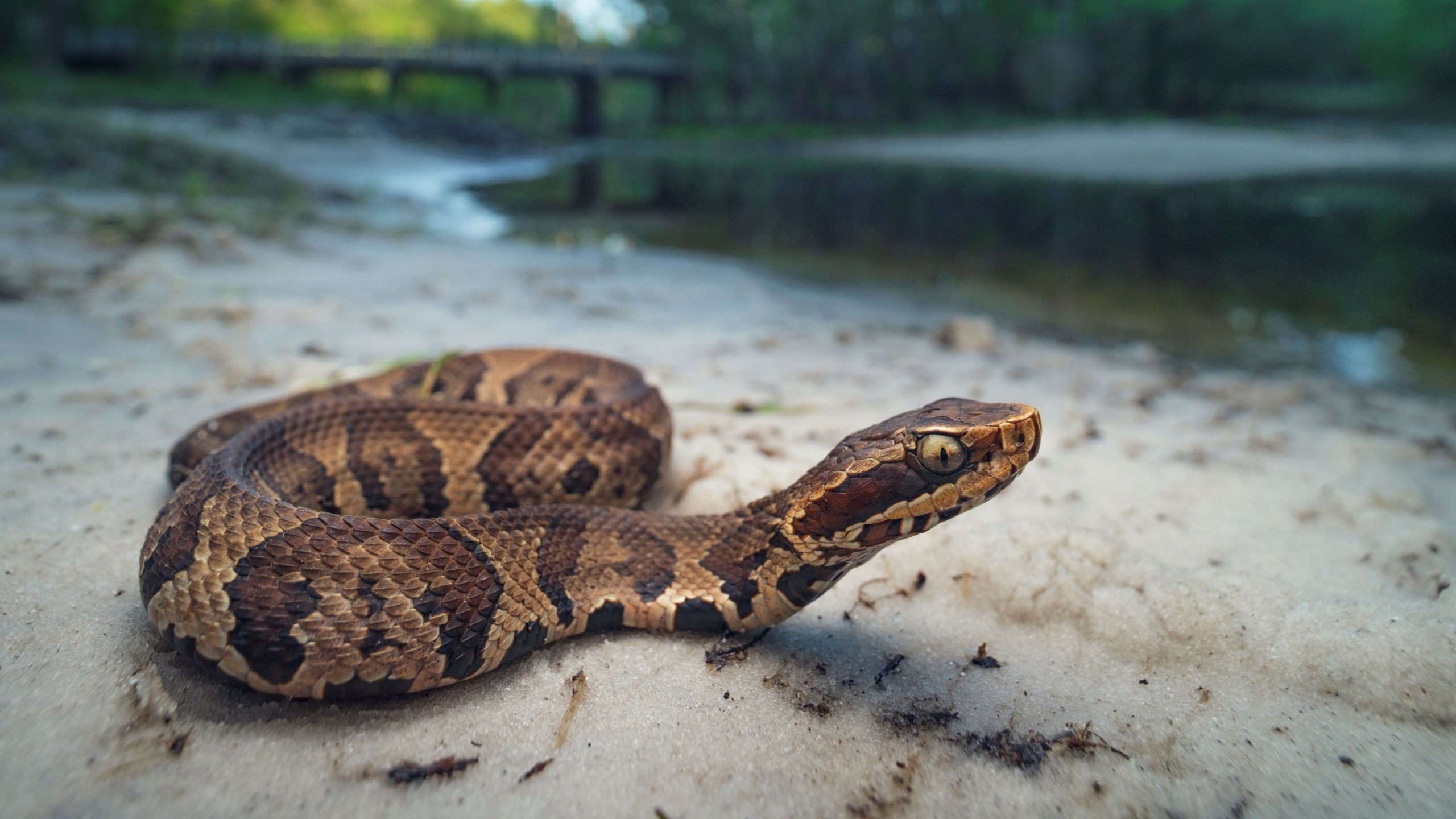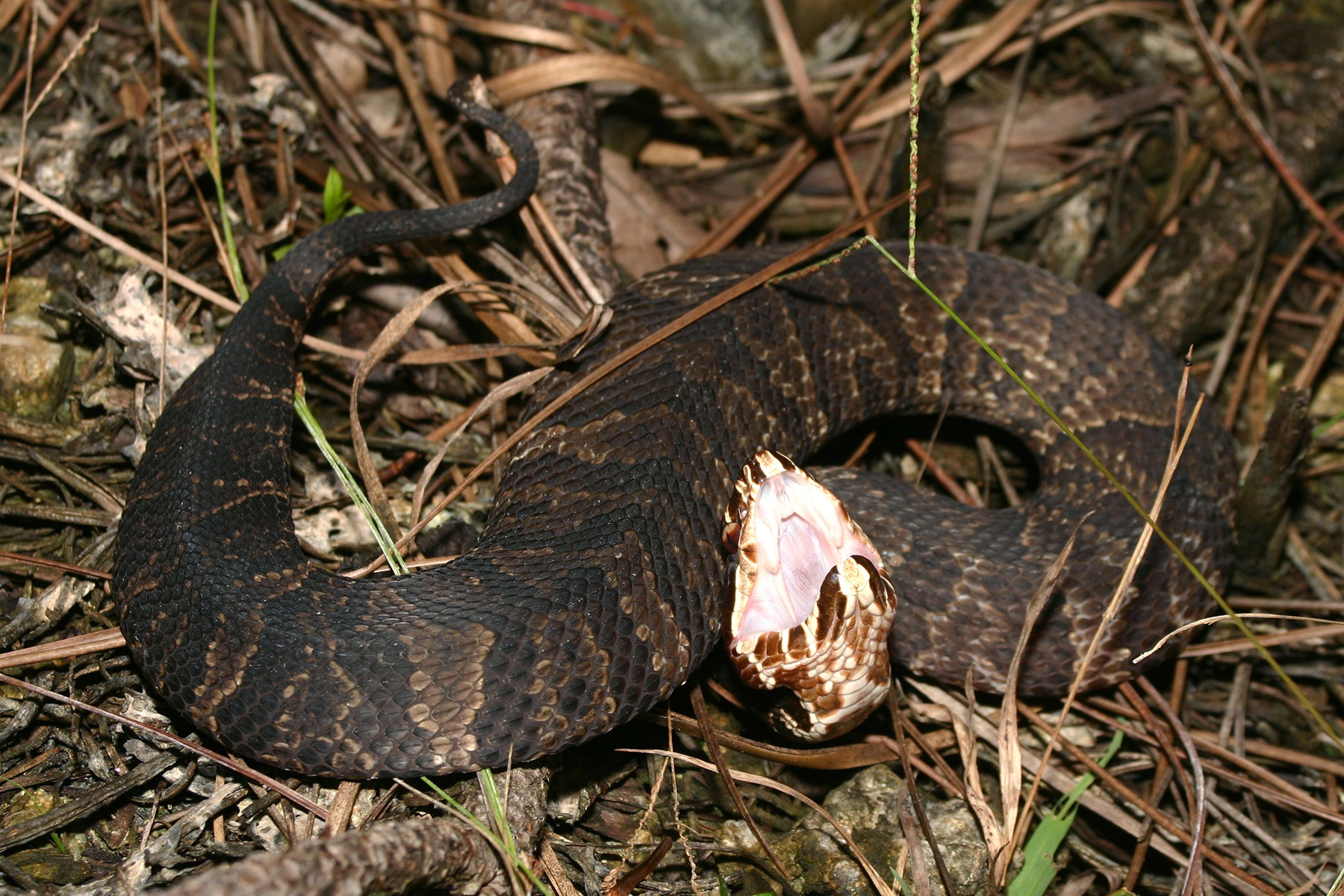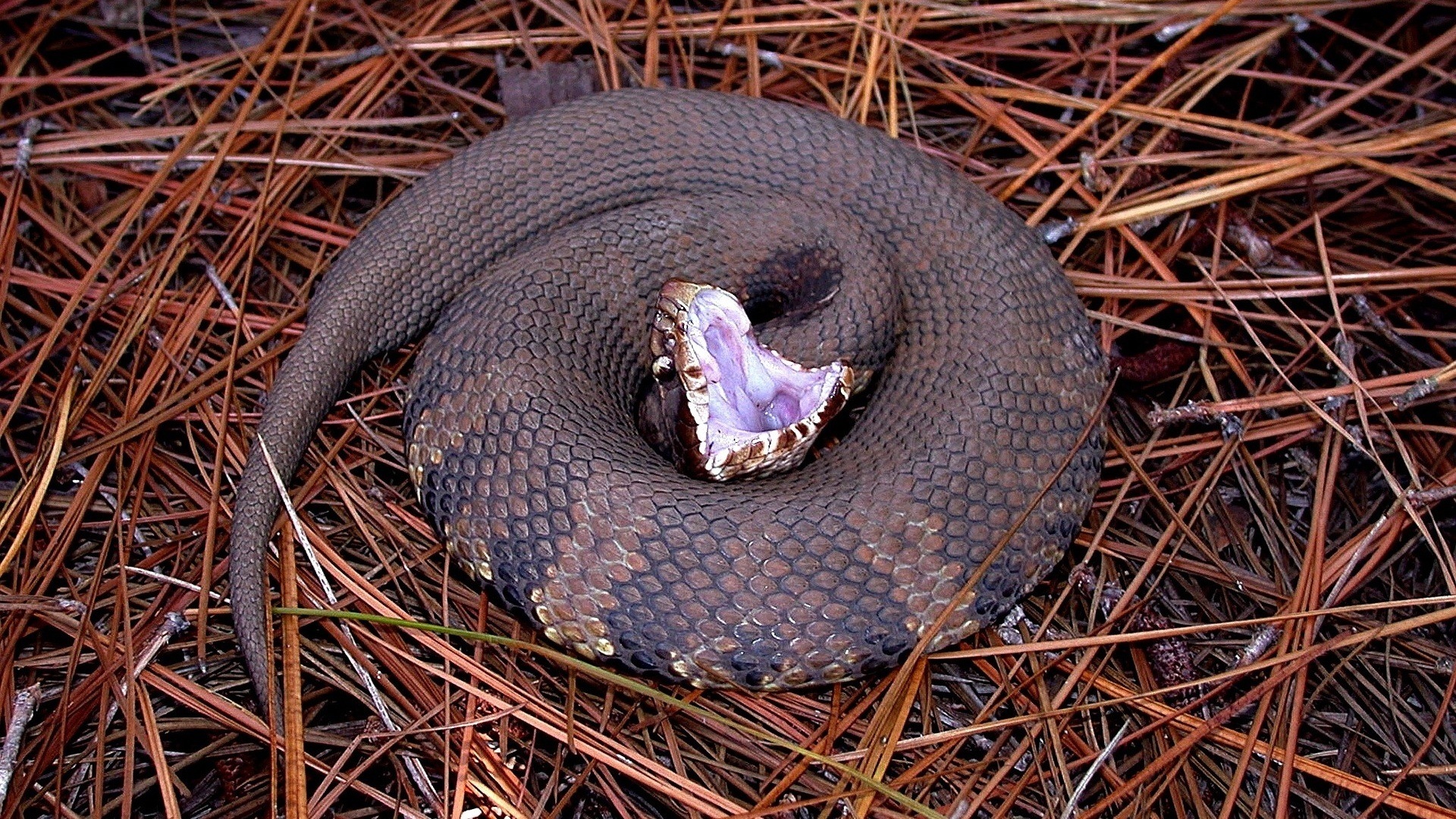Cottonmouth Snake - A Closer Look At The Water Moccasin
When you think about the natural world, particularly the damp, warm places across the southeastern parts of the United States, there's a creature that sometimes pops into mind, one that certainly commands a bit of respect. This creature, a kind of snake, is known by a few different names, but perhaps the most common one is the cottonmouth, or water moccasin. It's a snake that, as a matter of fact, has a rather distinctive way of showing you its presence, often revealing the pale inside of its mouth, which is how it gets its primary name. You might even, in some respects, say it's a bit of a local celebrity in its habitat, though not one you'd necessarily want to get too close to.
This particular reptile makes its home in places where water is plentiful, like the edges of creeks, in swamps, or even just along the banks of slow-moving rivers. It's an animal that, you know, has adapted quite well to its surroundings, blending into the muddy banks and leafy debris. People who spend time outdoors in these areas, perhaps fishing or just enjoying nature, are the ones who might, arguably, have the chance to see one of these snakes. They are, after all, a part of the natural fabric of these watery environments, playing their part in the delicate balance of life there.
The cottonmouth snake, a member of a group of snakes called pit vipers, possesses certain features that help it survive and thrive in its wet world. It's a creature that, in a way, carries a certain reputation, mostly because of its potent bite. While encounters that lead to bites are, you know, quite rare, it's still good to know a bit about them, just to be on the safe side. This discussion will, basically, give you a clearer picture of this interesting animal, from where it lives to how it behaves, and what makes it so special in its own right.
Table of Contents
- What is a Cottonmouth Snake?
- Identifying the Cottonmouth Snake
- Where Do Cottonmouth Snakes Live?
- The Cottonmouth Snake's Territory
- How Do Cottonmouth Snakes Hunt?
- The Cottonmouth Snake's Special Senses
- Are Cottonmouth Snake Bites Serious?
- Understanding Cottonmouth Snake Venom
- What to do if you encounter a cottonmouth snake?
What is a Cottonmouth Snake?
The creature we are talking about, the cottonmouth snake, is officially known to science as *Agkistrodon piscivorus*. It's a type of snake that, you know, belongs to a very specific branch of the snake family tree. To be precise, it's a pit viper, which places it within the subfamily called Crotalinae, and that whole group is part of the larger Viperidae family. This family, the Viperidae, includes snakes that, as a matter of fact, have a unique way of delivering their defensive or predatory substances. They are, essentially, snakes that come with a built-in method for injecting a potent liquid. This particular snake, the cottonmouth, is, apparently, one of the more recognized members of this group in its home region. It's a snake that, in a way, carries a bit of a reputation, mostly due to its nature as a creature that can deliver a powerful bite.
Beyond its scientific name, this snake has quite a few common names, which can sometimes cause a little confusion, but they all point to the same animal. Most people, in fact, know it as the water moccasin. That name, of course, gives you a pretty good hint about where you might find it – usually near water. But it also goes by other names, depending on where you are or who you're talking to. Some folks, for instance, might call it a swamp moccasin, which, you know, makes sense given its preferred wet and muddy places. Others might refer to it as a black moccasin, especially if they've seen one that has a darker skin tone. And then, you know, sometimes people just call it a viper, which is a broader term but still points to its family lineage. These different names, you see, reflect the various ways people have come to know and identify this animal over time, usually based on its looks or where it lives.
Identifying the Cottonmouth Snake
When it comes to telling a cottonmouth snake apart from other snakes, there are a few things to look for, some rather clear signs that, you know, really stand out. One of the most talked-about features, and the one that gives the snake its most common name, is the inside of its mouth. When this snake feels threatened or wants to warn someone or something away, it will, you know, often open its mouth wide. And when it does, you'll see a lining that is strikingly white, almost like cotton. This display, actually, is a very clear signal that you're dealing with a cottonmouth, and it's a behavior that is pretty unique to this particular reptile. It's a warning, basically, that says, "Stay away!" without the snake having to move or strike. This visual cue is, in a way, a very effective form of communication in the natural world.
Beyond the mouth display, there are other physical traits that can help you identify a cottonmouth snake. These snakes, you know, typically have heads that are shaped like a triangle, which is a common characteristic among many snakes that carry a potent substance. Their eyes also have pupils that are vertical, almost like a cat's eye, rather than round. And then, there's a special feature that's a bit harder to spot unless you're quite close, which is a deep facial pit. This pit, you see, is located on each side of its face, right there between its eye and its nostril. This particular feature, the facial pit, is a sensory organ that, as a matter of fact, helps the snake in its daily life, especially when it's looking for food. It's a very specialized tool that, you know, gives the cottonmouth snake a distinct advantage in its environment.
It's important to remember that some other snakes, like certain kinds of water snakes, can look a bit similar to a cottonmouth, especially from a distance. However, these other water snakes, basically, do not have the triangular head shape, nor do they possess the vertical pupils or the facial pits that are so characteristic of the cottonmouth snake. And, you know, their behavior is also often different. When a non-venomous water snake feels threatened, it will typically try to get away, often by fleeing into the water and swimming off. The cottonmouth, on the other hand, might hold its ground or even coil up and open its mouth, showing that distinctive white lining. So, paying attention to these small but important details can, in a way, really help you tell the difference between a cottonmouth snake and a harmless look-alike.
Where Do Cottonmouth Snakes Live?
The cottonmouth snake, as its common name "water moccasin" suggests, is an animal that, you know, really likes to be around water. Its natural home, or its native territory, stretches across a significant portion of the southeastern United States. This means that if you're in states like Florida, Georgia, Alabama, Mississippi, Louisiana, or even parts of Texas, you might, apparently, come across one of these snakes. They are, you see, particularly fond of wet places, like swamps, marshes, ponds, lakes, and the slow-moving parts of rivers and creeks. They can often be found resting on branches that hang over the water, or perhaps, you know, just basking on a sunny bank near the edge of a pond. Their preference for these damp environments means they are, in a way, very much a part of the watery scenery in these regions.
One specific example of where these snakes can be found is, for instance, on the edge of a creek in Oklahoma. This particular sighting, you know, just goes to show how widespread their presence is within their established range. They are, basically, quite adaptable to different kinds of wet habitats, as long as there's enough food and cover for them. The climate in the southeastern U.S., with its warm temperatures and plenty of rainfall, is, in fact, quite suitable for these cold-blooded creatures. They need the warmth to regulate their body temperature, and the abundant water provides both a place to live and a source of food. So, if you're ever in these parts, especially near any kind of standing or slow-moving water, it's good to be aware that a cottonmouth snake might, you know, be living nearby.
The Cottonmouth Snake's Territory
The area where the cottonmouth snake makes its home is, you know, quite extensive, stretching from one side of the country's southern region to the other. Their territory, in fact, reaches all the way from the state of Texas, which is in the southwest, and extends eastward across many states until it hits the eastern seaboard. This means they are present in a wide variety of landscapes, from the bayous of Louisiana to the wetlands of Florida, and up along the coastal plains of states like North Carolina and Virginia. It's a pretty large stretch of land, and within this vast area, the snakes find all the necessary conditions to thrive: warmth, water, and plenty of prey. This wide distribution, you see, speaks to their ability to adapt to different types of aquatic environments, as long as the basic needs are met. They are, in a way, a true emblem of the southern wetlands.
Within this broad territory, the cottonmouth snake tends to stick to places that offer them both safety and opportunities to find food. They are, you know, often found coiled up on rocks or logs near the water's edge, or sometimes they might be swimming slowly across the surface. They are, basically, very much at home in the water, and they can even hunt in it. Their presence in these areas is, in fact, a natural part of the ecosystem, as they play a role in keeping populations of small animals in check. So, when you're exploring these watery habitats in the southeastern United States, it's always a good idea to keep an eye out for these interesting creatures, as they are, you know, quite common residents of such places.
How Do Cottonmouth Snakes Hunt?
The cottonmouth snake is, you know, a very effective hunter in its watery environment, and it uses some pretty clever tools to find its meals. As a pit viper, one of its most remarkable features is that deep facial pit we talked about earlier. This pit, you see, is not just a random indentation; it's actually a highly specialized sensory organ. It acts, basically, like a thermal detector, allowing the snake to "see" the heat given off by other living things. So, even in complete darkness, or if its prey is perfectly still and camouflaged, the cottonmouth snake can, in a way, detect the warmth of a small animal nearby. This ability to sense body heat is, in fact, a huge advantage for a hunter, especially for one that often hunts at night or in murky water. It's almost like having a built-in infrared camera, which, you know, is pretty cool for a snake.
Once the cottonmouth snake has located its prey using its heat-sensing pits, it then moves in to capture it. The snake's hunting strategy is, you know, quite direct. It relies on a quick strike and the injection of its potent substance. This substance, the venom, is what helps the snake subdue its meal. When the snake delivers a bite, it can, in fact, inject this venom into its prey, whether that's a small fish, a frog, or even a bird that comes too close to the water's edge. The venom works quite quickly, causing the animal to become incapacitated, which then allows the cottonmouth snake to consume its meal without much trouble. This efficient method means the snake doesn't have to struggle with its prey for long, saving it energy and reducing the risk of injury. It's a very effective way to get food in its natural habitat.
The Cottonmouth Snake's Special Senses
Beyond the amazing heat-sensing pits, the cottonmouth snake also possesses other features that help it perceive its surroundings and locate food. Its eyes, for instance, have vertical pupils, which are quite distinct from the round pupils found in many other animals. These vertical pupils, you know, are often associated with creatures that are more active during the twilight hours or at night, allowing for better vision in low light conditions. While the heat pits are its primary tool for finding warm-blooded prey, its vision still plays a role, especially during the day. The combination of these senses means the cottonmouth snake is, basically, well-equipped to navigate its environment and find food, whether it's day or night. It's a creature that, in a way, uses all its available tools to survive and thrive.
It's also worth noting that the cottonmouth snake's overall body design, including its triangular head shape, contributes to its hunting prowess. The head shape, you see, isn't just for looks; it houses the venom glands and the muscles needed for a powerful strike. When the snake strikes, it does so with speed and precision, aiming to deliver its venom effectively. This entire process, from sensing the heat of a potential meal to delivering the incapacitating bite, is a testament to the cottonmouth snake's specialized adaptations for its role as a predator in its watery world. It's a creature that, you know, is truly built for its purpose, and every part of it, apparently, serves a function in its survival.
Are Cottonmouth Snake Bites Serious?
The cottonmouth snake, as we've discussed, is a venomous animal, and that means its bite does carry a level of danger. It's true that the bite of a cottonmouth snake is potentially fatal, meaning it could, in some cases, cause very serious harm or even be life-threatening. However, it's really important to put this into perspective. Bites from cottonmouth snakes are, you know, quite rare. These snakes generally prefer to avoid people, and they will usually try to get away or give a warning before resorting to a bite. They don't, basically, go looking for trouble, and a bite is usually a last resort when they feel cornered or directly threatened. So, while the potential for serious harm is there, the actual occurrence of bites is, in fact, not very common, which is, you know, a good thing for both people and snakes.
When a cottonmouth snake does bite, it can inject its venom into the target. This venom is a complex substance that, you know, works to break down tissues and cause other effects in the body. For prey, this means a quick incapacitation, allowing the snake to consume its meal. For a larger animal or a person, the effects can include swelling, pain, and damage to the affected area. While the bite is serious and requires immediate medical attention, it's also worth noting that medical advancements mean that the chances of a fatal outcome for a human are, you know, quite low if proper care is received quickly. So, while caution is always advised around these animals, extreme fear is, perhaps, not always necessary, given the rarity of bites and the availability of treatment. It's a situation that, in a way, calls for respect rather than panic.
Understanding Cottonmouth Snake Venom
The venom produced by the cottonmouth snake, like that of all pit vipers, is a powerful mix of proteins and enzymes. When this venom is injected, it causes a variety of effects in the body of the creature that receives it. For instance, it can cause damage to blood vessels, leading to swelling and bruising around the bite area. It can also interfere with the body's ability to clot blood, which can make bleeding worse. The venom's purpose, you know, is to help the snake digest its prey, so it starts breaking down tissues even before the meal is swallowed. This is why, for a person, a cottonmouth snake bite can be very painful and cause significant local tissue damage. It's a potent substance that, you know, is designed to work quickly and effectively on its targets. Understanding what the venom does helps us appreciate why seeking medical help is so important after a bite.
What to do if you encounter a cottonmouth snake?
If you happen to come across a cottonmouth snake, the best thing to do, you know, is simply to give it plenty of space. These snakes are not aggressive by nature and will usually try to avoid confrontation. If you see one, just slowly back away and go around it. Do not, in fact, try to pick it up, poke it with a stick, or try to move it. This is when bites are most likely to happen, when the snake feels threatened or cornered. Remember that the snake is just trying to live its life in its natural home, and it views people as potential threats, not as something to attack without reason. So, observing from a distance is, basically, the safest and most respectful way to interact with these interesting creatures. It's a simple rule that, you know, helps keep everyone safe in the outdoors.
- Quinn Finite
- Angel Fangs After2000 01 01 Before2010 01 01
- Anthony Bourdain
- Iso Meaning
- Dumbbell Front Raise

Cottonmouth snakes: Facts about water moccasins | Live Science

Cottonmouth Snake Bite

Central Florida Zoo & Botanical Gardens Cottonmouth - Central Florida